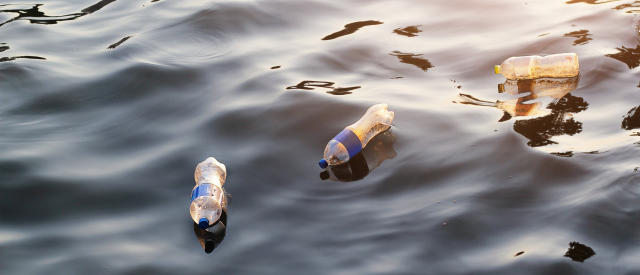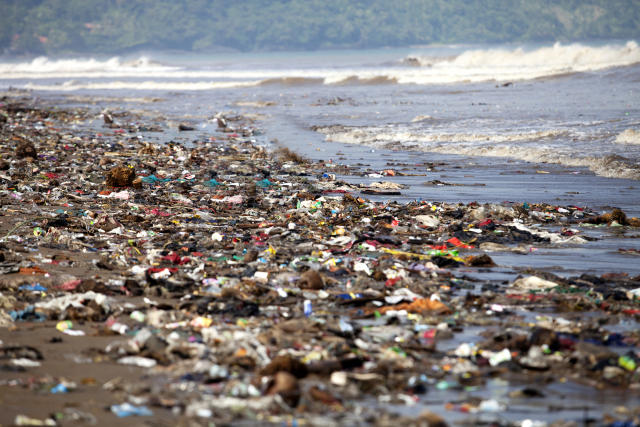Plastic waste: A global problem and an opportunity for microbiology
Posted on May 1, 2018 by Roya Ziaie
Public appetite for reducing plastic waste is insatiable following the release of Blue Planet II; a series narrated by David Attenborough and focusing on the impact of human activity on the marine.
At the Microbiology Society’s Annual Conference 2018, delegates heard from Professor Kevin O’Connor, a leading principal investigator at University College Dublin. In his talk ‘Plastic waste: A global problem and an opportunity for microbiology’, he described strategies to reduce plastic waste, consumer confusion and opportunities for the future.

The plastic problem:
Due to its versatility, plastic is used in billions of products worldwide, and we are predicted to produce over 600 million tonnes of it by 2035. The plastic production industry employs 1.5 million people in Europe, plastics play a key role in reducing greenhouse gases (GHGs) by allowing us to build stronger and lighter vehicles and better insulate homes.
However, the production and incineration of plastic contributes to over 400 million tonnes of carbon dioxide emissions annually and single use plastics are major pollutants on land and in the sea. Alternative materials or methods of plastic management are desperately needed. Many consumers are already aware that plastics are recyclable – why isn’t there an efficient recycling system already in place? Currently, less than 30% of all plastic waste in Europe is collected for recycling, with recycling rates in many other regions even lower. This may be because recycled plastics produce lower quality products than virgin plastics and are aesthetically less appealing to consumers.
Eighty percent of marine litter is made up of plastics. Items such as straws, coffee cup lids, plastic bottles, and plastic bags are single use items that make up the majority of beach pollution. Polyethylene terephthalate (PET) plastic bottles and containers can take up to 1,000 years to break down in the environment.
Micro-plastics are also a major issue. Defined as plastics that are less than 5 millimetres in length, micro-plastics are formed in a variety of ways including through degradation of larger debris or are manufactured as micro-beads for use as exfoliants in beauty products such as cleansers and toothpastes. These minute particles often pass through water filtration systems, ending up in oceans and lakes. Micro-plastics can be extremely damaging to aquatic life; they can be mistaken for food by smaller fish and eventually enter the food chain in the guts of fish we eat.
If we can’t prevent the use of plastics, then society should work to reduce its consumption. Do we really need that much packaging? How can we design plastics to aid their re-use?
Tackling plastic waste:
In 1999, Kevin and his team began to investigate the reuse of petrochemical plastic waste. They used pyrolysis – a thermal decomposition method that reduces petrochemical plastic polymers to their precursors, or monomers. These monomers were then fed to the bacteria Psuedomonas putida. After consuming the petroplastic monomers, the bacteria produced biodegradable plastic polymers called polyhydroxyalkanoates (PHAs). PHAs break down in the environment to produce no harmful by-products, and were shown to perform either as well as, or better than, petrochemical polymers used for products such as glues, making them a viable alternative use in things like post-it notes.
Kevin’s team also focused on biodegradable polymers and how well they degrade in managed and non-managed environments. These included industrial composting, home composting and the marine, each of which has different composting standards. Ranging from industrial processes, which require plastics to degrade within 180 days at around 50°C, to the marine, which requires plastics degrade after 56 days at 30°C.
What became clear was that different plastics, even those within the same polymer family, vary greatly in their rate of degradation in different environments. The fastest growing biodegradable plastic in the consumer market, polylactic acid (PLA), does not degrade at all in the 28°C conditions seen in home composting. Similarly, many plastics degrade poorly in the marine. With a well-managed industrial composting method however, biodegradable plastic produced fantastic results.
More research is needed to ensure that biodegradation is possible for different plastics in different environments, something which will need to be built into the design of new products.

The ultimate reality we face is that there is no quick-fix, and biodegradable plastics still need to be managed in the same way as petrochemical ones. A lack of clear messaging on the difference between biobased and biodegradable plastics is causing confusion for consumers and will not build consumer confidence.
Responsible consumption should continue to be promoted, and initiatives to reduce plastic waste implemented quickly. Charges on supermarket carrier bags have already seen a 95% reduction in their use across Ireland, and 80% across England.
The war has officially been waged on plastics, with the government working with trade associations, campaigners and over 40 companies to eliminate single-use packaging under the UK Plastics Pact. Individuals can also play their part, by purchasing a re-usable coffee cup or water bottle, taking a canvas bag to the supermarket and saying no to plastic straws and cutlery. Small changes can have big impact, and as Kevin O’Connor powerfully stated, the solution to plastic waste is us.
